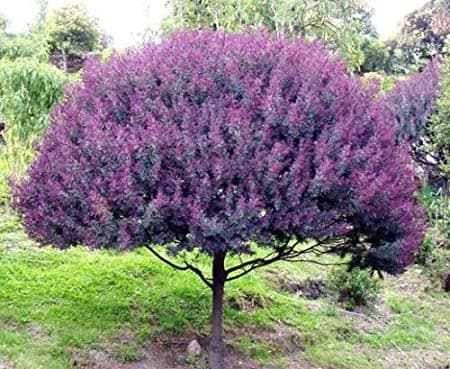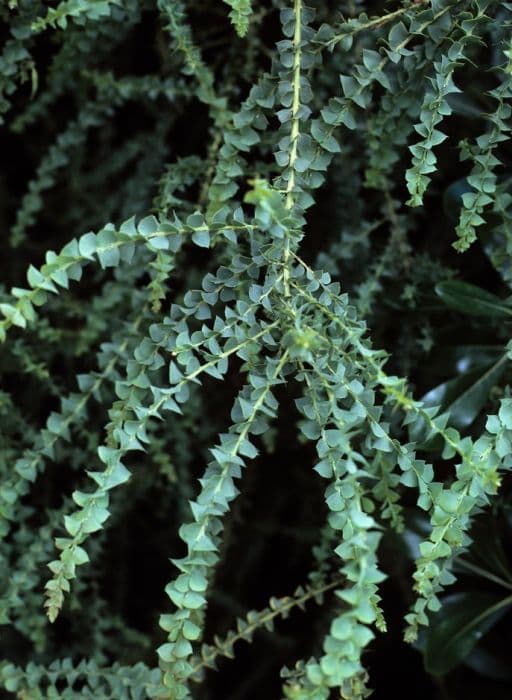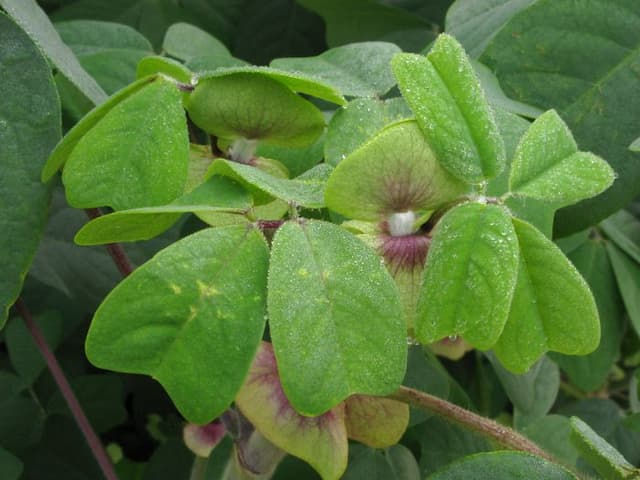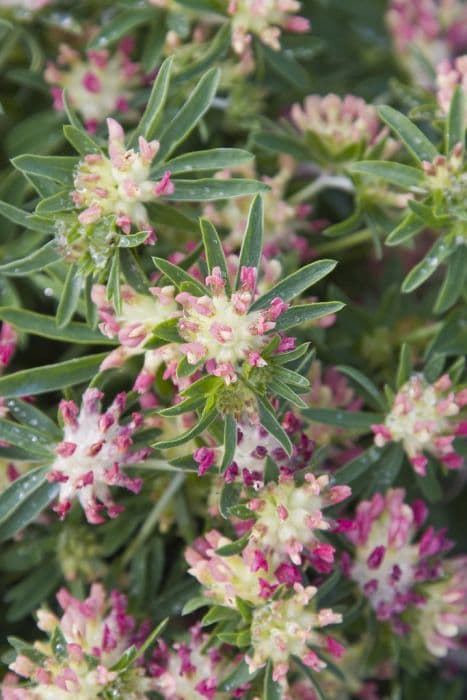Stevenson's Broom Carmichaelia stevensonii

ABOUT
Carmichaelia stevensonii, commonly known as Stevenson's broom, is a visually unique plant presenting a distinct leafless appearance. Its slender green branches resemble needle-like structures, which serve the function of leaves, a feature that sets this plant apart from many others with broader, more traditional leaves. The delicate branches bear the responsibility for photosynthesis and give the plant an airy, feathery look. During the flowering season, Stevenson's broom comes alive with small, pea-like flowers that can range in color, typically showcasing soft hues that contribute to the overall delicate demeanor of the plant. Although these flowers may be petite, they offer a subtle charm that is characteristic of many broom species. After the flowering season, pods that contain the seeds may develop, and these pods usually split open when ripe, naturally dispersing the seeds. Stevenson's broom has a fine-textured visual quality that enables it to blend in naturally with sparsely vegetated habitats.
About this plant
 Names
NamesFamily
Fabaceae
Synonyms
Stevenson's Broom
Common names
Carmichaelia stevensonii
 Toxicity
ToxicityTo humans
Regarding the toxicity of the New Zealand broom (Carmichaelia stevensonii) to humans, there is limited detailed information readily available. Most species in the Carmichaelia genus are not commonly reported as toxic to humans. However, as a general precaution, it is always wise to avoid ingesting unknown plants or plant parts due to potential risks that may not be well-documented. If a person ingests New Zealand broom and experiences negative symptoms, it is important to seek medical advice. The symptoms of plant poisoning can vary widely but may include nausea, vomiting, diarrhea, and in severe cases, organ damage or life-threatening conditions.
To pets
The toxicity of New Zealand broom (Carmichaelia stevensonii) to pets is not well-documented in available resources. Many plants in the Carmichaelia genus are not known for being harmful to animals. However, it is advisable to prevent pets from eating this or any other unknown plants, as they may contain compounds that could potentially be toxic. If a pet consumes New Zealand broom and exhibits symptoms such as vomiting, diarrhea, drooling, lethargy, or any unusual behavior, it is essential to consult a veterinarian. The dangers of plant ingestion in pets can range from mild gastrointestinal upset to more severe health issues, depending on the amount ingested and the pet's sensitivity to the plant.
 Characteristics
CharacteristicsLife cycle
Perennials
Foliage type
Deciduous
Color of leaves
Green
Flower color
Purple
Height
3-6 feet (0.91-1.83 meters)
Spread
2-4 feet (0.61-1.22 meters)
Plant type
Shrub
Hardiness zones
8
Native area
New Zealand
Benefits
 General Benefits
General Benefits- Ecosystem support: Carmichaelia stevensonii, commonly known as Stevenson's broom, provides habitat and food for local wildlife, including insects and birds.
- Nitrogen fixation: Stevenson's broom is a member of the pea family, which has the ability to fix atmospheric nitrogen through symbiotic relationships with root bacteria, enriching the soil.
- Erosion control: The shrubby growth form of Stevenson's broom helps stabilize the soil with its root system, reducing the impact of erosion on the landscape.
- Landscape aesthetics: Stevenson's broom has unique visual characteristics, such as its slender green branches and tiny leaves, which can add aesthetic value to gardens and natural spaces.
- Cultural significance: Native plants like Stevenson's broom are often of cultural importance to indigenous people and can be used in restoration projects to preserve natural heritage.
- Pollinator support: This plant provides nectar and pollen for insects, contributing to the health of pollinator populations, which are crucial for the pollination of many other plant species.
- Drought tolerance: As a native to dry environments, Stevenson's broom is adapted to survive with minimal water, making it suitable for xeriscaping and drought-prone areas.
 Medical Properties
Medical PropertiesThis plant is not used for medical purposes.
 Air-purifying Qualities
Air-purifying QualitiesThis plant is not specifically known for air purifying qualities.
 Other Uses
Other Uses- The branches of Carmichaelia stevensonii, also known as dwarf broom, can be used in crafting small objects, such as miniature brooms or decorative household items, due to their sturdy and fibrous nature.
- Traditional Maori used various species of Carmichaelia for constructing fish traps and weirs, acknowledging the plant's durability when immersed in water over time.
- The wood is sometimes carved into simple tools or used as handles for small implements, leveraging its strength and ease of shaping.
- Dwarf broom can be used in landscaping to stabilize soil, especially in rock gardens or on slopes where erosion control is needed.
- Owing to its unique appearance, dwarf broom is sometimes used in floral arrangements, particularly in regions where the plant is native or well-known.
- The plant's ability to thrive in poor soil makes it ideal for reclaiming or rehabilitating disturbed areas and mine sites with low-nutrient soils.
- In smaller gardens or confined spaces, Carmichaelia stevensonii serves as an ornamental feature due to its distinctive growth habit and adaptation to a variety of growing conditions.
- The plant can provide habitat and shelter for certain native insects and small animals, contributing to the local biodiversity.
- The dense, interlocking nature of Carmichaelia stevensonii branches could potentially be utilized in living fences or barriers for livestock on farms.
- When dried properly, the woody parts of the plant can be used as a source of biomass fuel for small-scale heating purposes.
Interesting Facts
 Feng Shui
Feng ShuiThe plant Carmichaelia stevensonii, commonly known as Stevenson's broom, is not used in Feng Shui practice.
 Zodiac Sign Compitability
Zodiac Sign CompitabilityThe plant Carmichaelia stevensonii, commonly known as Stevenson's broom, is not used in astrology practice.
 Plant Symbolism
Plant Symbolism- Resilience: Carmichaelia stevensonii, also known as "Stevenson's broom," is a plant that grows in harsh environments, symbolizing the ability to endure and thrive in difficult conditions.
- Adaptability: As a species native to New Zealand, Stevenson's broom has adapted to its unique ecosystem, representing adaptability and the ability to thrive in changing circumstances.
- Rarity: Due to its specific habitat requirements, Stevenson's broom is not commonly found, which can symbolize uniqueness and the value of rare beauty in life.
 Water
WaterFor New Zealand broom, also known as Carmichaelia stevensonii, it's important to water the plant carefully as it prefers well-drained soil and does not tolerate waterlogged conditions. In general, watering should be done once a week, allowing the soil to dry out slightly between watering sessions. The amount of water will depend on the size of the plant and the climate; however, as a guideline, use about 1 gallon for a medium-sized shrub each time you water. During the hot summer months, you might need to water more frequently, while in the cooler winter months, watering can be reduced.
 Light
LightNew Zealand broom thrives best in full sunlight to partial shade. Ideally, it should receive at least 6 hours of direct sunlight per day. If you're growing it indoors, place it near a south-facing window where it can get plenty of bright, indirect light. Avoid deep shade as this can hinder the plant's growth and flowering capabilities.
 Temperature
TemperatureFor New Zealand broom, the ideal temperature range is between 60°F and 75°F. It can survive occasional dips down to 50°F and can tolerate short periods of higher temperatures up to around 85°F. However, it's important to shield the plant from frost and prolonged cold, as it may not withstand temperatures significantly below 50°F.
 Pruning
PruningPrune New Zealand broom to maintain its shape and remove any dead or damaged branches. Light pruning can be done anytime throughout the year as needed, but the best time for heavier shaping is after the plant has flowered in the late spring or early summer. If the plant becomes leggy, a harder prune can encourage bushier growth, but avoid cutting into old wood where new growth may not sprout.
 Cleaning
CleaningAs needed
 Soil
SoilThe best soil mix for New Zealand Broom (Carmichaelia stevensonii) should be well-draining with good aeration, such as a mixture of loam, sand, and a small amount of organic matter. The soil pH should be neutral to slightly alkaline, around 7.0 to 7.5.
 Repotting
RepottingNew Zealand Broom (Carmichaelia stevensonii) should be repotted approximately every two to three years to prevent it from becoming root-bound and to replenish the nutrients in the soil.
 Humidity & Misting
Humidity & MistingNew Zealand Broom (Carmichaelia stevensonii) typically prefers low to moderate humidity levels, similar to its natural dry habitat conditions.
 Suitable locations
Suitable locationsIndoor
Keep in bright, indirect light and in well-draining soil.
Outdoor
Plant in full sun with well-drained soil and low water.
Hardiness zone
8-10 USDA
 Life cycle
Life cycleCarmichaelia stevensonii, commonly known as Stevenson's broom, begins its life as a seed that germinates in well-draining soil in spring or early summer. The seedling develops a taproot and delicate foliage, adapting to New Zealand's alpine or subalpine environments where it is endemic. As the plant matures, it forms a small, woody shrub with distinctively thin, wire-like, leafless stems, a physical adaptation to its dry habitat. It flowers in the summer, producing small, purple or blue pea-like flowers that are pollinated by insects, especially bees. Following pollination, the plant develops seed pods which eventually dry and split open, dispersing seeds that will begin the next generation. Stevenson's broom is adapted to survive in harsh conditions, with a lifespan that can extend over several years depending on environmental factors.
 Propogation
PropogationPropogation time
Spring to Summer
The most popular method of propagation for Carmichaelia stevensonii, commonly known as the leafless broom, is through seed collection and sowing. Seeds should be harvested when the pods have dried on the plant, typically in late summer. These seeds can then be sown in well-draining soil in a sunny location. It's important to sow the seeds at a shallow depth, approximately 1/4 inch (about 6 millimeters) deep. Seeds usually germinate within two to eight weeks, and it is essential to keep the soil moist but not waterlogged during this period. Seedlings can be transplanted once they are large enough to handle. This propagation method allows gardeners to produce a large number of plants relatively easily.









